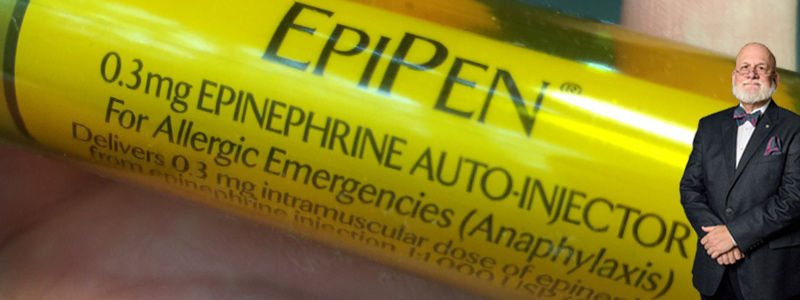There are millions of people with allergies so severe they can slip into anaphylaxis if they encounter one of the substances they’re allergic to – from bee stings to tree nuts, shellfish, and many more.
When food causes a reaction the allergic response can develop slowly, giving the victim time to recognize the symptoms, start treatment, and call for help. In the case of stings or bites, the toxins are injected directly into the body where they begin reacting almost immediately. People in that category have but a few minutes to react and get help.
The most common emergency treatment for all anaphylactic (allergic) reactions involves an injection of epinephrine and a trip to a hospital as soon as possible. A single shot of epinephrine is usually enough, but severe situations may require more. Sufferers have been given instruction by their doctor on how to use the epinephrine and emergency personnel are well versed in proper use of the drug and other anti-allergy medicines. A key to successful treatment is injecting epinephrine as soon as possible.
There’s a product on the market that can deliver an epinephrine injection quickly, called an EpiPen. Many people carry these devices all the time – and students have them on hand at schools. Patients know how to use them and so do teachers. The pen devices are quick and simple but have some serious drawbacks. They have a very short shelf life – around a year or so – meaning they must be replaced often because it is possible the device will not be totally effective if used beyond the expiration date. They are also very expensive – which is complicated further by the fact they need to be replaced so often – at costs around $600.00 for two. Not too long ago the prices was under $60.00.
Thankfully, most potential victims never need to use the injection because they avoid the materials that cause their reaction. That means the cost is a form of insurance against the possible but improbable. The drug makers can make the point that $600.00 per year (less than $2.00 per day) is a reasonable price to pay to be insured that emergency treatment is immediately available.
There would be a legitimate reason for the high cost if the medicine itself was costly to produce. In fact, though, epinephrine has been on the market for decades and it is off patent, but the EpiPen makers charge what they want. Recent reports explain that the CEO of the company benefits from a 400% salary increase – to well over $15million per year.
A 1ml ampule of epinephrine would cost under $5.00 and could deliver approximately 3 doses of 0.3ml each. Using the ampule of epinephrine and a syringe would require minimal skill in drawing the correct dose and administering it. Once opened, the vial of epinephrine would probably be discarded. Even if 2 doses are tossed out, the cost for the one injection would remain in the $5.00 to $10.00 range, rather than $300.00 for one EpiPen.
Our free market system allows producers to charge what they want for their products even if it seems inappropriate to others. It is improbable that public outrage alone will put a halt to this particular high cost treatment – but it may. Regardless, there is an effective treatment that costs much less, but requires a bit more expertise. I’ve heard that some emergency centers are now controlling their costs by rejecting EpiPens and returning to ampules and syringes. Governor Rauner (IL) recently signed a bill that will save Illinois paramedics thousands of dollars when treating those who are having allergic reactions. Maybe that’s a reasonable alternative for everyone.
Part two of this story will offer more details on how to make the transition from EpiPen to vials and syringes.

